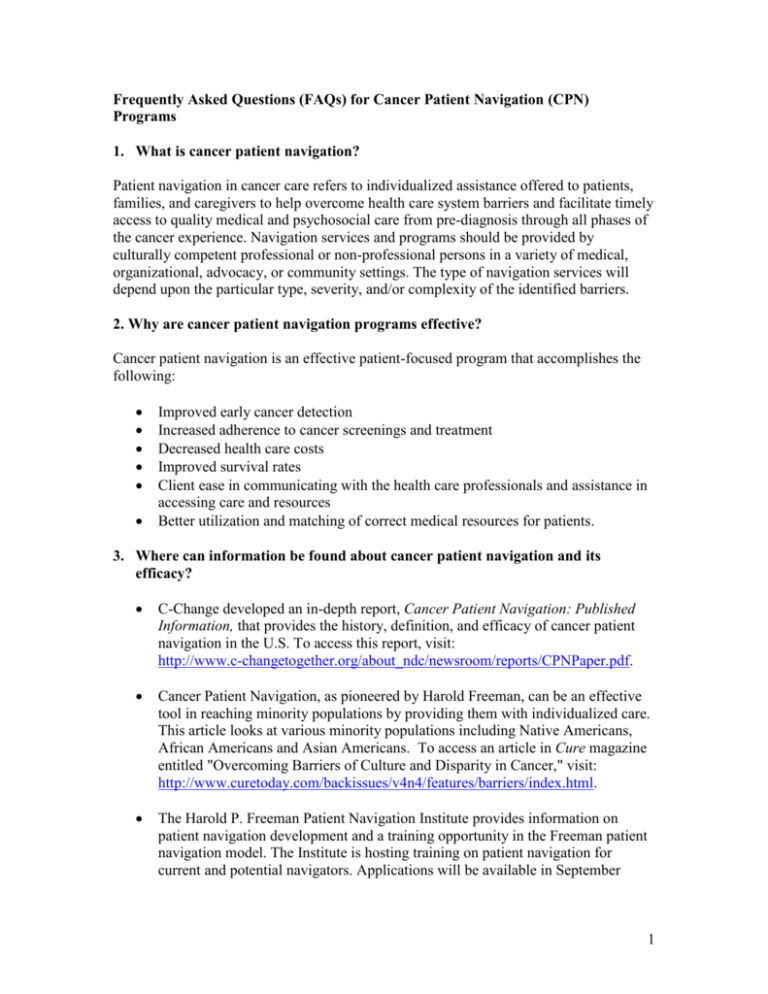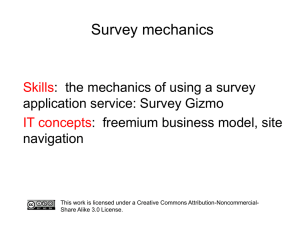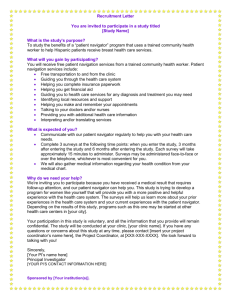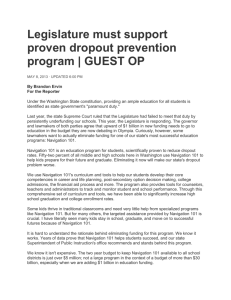- Cancer Patient Navigation
advertisement

Frequently Asked Questions (FAQs) for Cancer Patient Navigation (CPN) Programs 1. What is cancer patient navigation? Patient navigation in cancer care refers to individualized assistance offered to patients, families, and caregivers to help overcome health care system barriers and facilitate timely access to quality medical and psychosocial care from pre-diagnosis through all phases of the cancer experience. Navigation services and programs should be provided by culturally competent professional or non-professional persons in a variety of medical, organizational, advocacy, or community settings. The type of navigation services will depend upon the particular type, severity, and/or complexity of the identified barriers. 2. Why are cancer patient navigation programs effective? Cancer patient navigation is an effective patient-focused program that accomplishes the following: Improved early cancer detection Increased adherence to cancer screenings and treatment Decreased health care costs Improved survival rates Client ease in communicating with the health care professionals and assistance in accessing care and resources Better utilization and matching of correct medical resources for patients. 3. Where can information be found about cancer patient navigation and its efficacy? C-Change developed an in-depth report, Cancer Patient Navigation: Published Information, that provides the history, definition, and efficacy of cancer patient navigation in the U.S. To access this report, visit: http://www.c-changetogether.org/about_ndc/newsroom/reports/CPNPaper.pdf. Cancer Patient Navigation, as pioneered by Harold Freeman, can be an effective tool in reaching minority populations by providing them with individualized care. This article looks at various minority populations including Native Americans, African Americans and Asian Americans. To access an article in Cure magazine entitled "Overcoming Barriers of Culture and Disparity in Cancer," visit: http://www.curetoday.com/backissues/v4n4/features/barriers/index.html. The Harold P. Freeman Patient Navigation Institute provides information on patient navigation development and a training opportunity in the Freeman patient navigation model. The Institute is hosting training on patient navigation for current and potential navigators. Applications will be available in September 1 2007. For more information on the Institute, visit: http://www.ralphlaurencenter.org or call (212) 987-1777. 4. What is the cost of cancer patient navigation programs? The benefits of cancer patient navigation far outweigh the costs associated with these programs. The cost of patient navigation programs varies. Some CPNs use volunteer navigators who require oversight and supervision. Many programs use paid staff. Regional cost of living and salary variations affect startup and maintenance of patient navigation programs. Some of the costs to consider when starting a patient navigation program are: Personnel salary (i.e., social worker, nurse, lay health worker) Benefits Training Supervision Professional meetings or continuing education Office space and utilities Supplies Telephones including mobile phones Computers and networking needs Information technology support Transportation, travel/mileage reimbursement, and auto insurance protection, if home visits are included Marketing and outreach Sustainability and possible replacement costs from loss such as turnover of welltrained staff to other positions. 5. What are potential funding sources for cancer patient navigation programs? A 2003 National Cancer Institute survey identified more than 200 navigation programs nationally, many of which were funded by small grants from private foundations such as the Avon Foundation and the Susan G. Komen Foundation. It is important to consider all possible funding sources from local or regional community and/or corporate sources. Cancer patient navigation can be funded through sources such as: Private or public donations from community, organizational, or corporate sources Foundation grants State or federal legislation Government research grants Healthcare systems Restructuring some staff functions and employees into new positions. 2 6. What are the funding sources of the cancer navigation programs seen in the CChange video, Cancer Patient Navigation: Care for Your Community? The three programs featured on the C-Change Cancer Patient Navigation video provide a case study of three different communities that developed population-specific patient navigation programs with a variety of funding sources. a. Oakland, California: Program: Latina Breast Health Program; community, clinic, and hospital based Population: Suburban, Latina Navigators: Nurse and lay health workers Funding: Local Susan G. Komen Foundation grant for navigator salary in years one and three, hospital funding for year two salary plus administrative resources b. Chicago, Illinois: Program: Two navigation programs; one hospital based, one community based Population: Urban, African-American, Latino, and many other ethnic groups Navigators: Social workers and lay health workers Funding: American Cancer Society, National Cancer Institute, with additional administrative and other resources provided by Northwestern Hospital, University of Illinois Chicago, and Access Community Health Network c. Jackson, Kentucky: Program: Kentucky Homeplace; community based navigation Population: Rural, poor Appalachian Navigators: Nurse and lay health workers Funding: Mandated by the state legislature, additional administrative resources provided by University of Kentucky Center for Rural Health and Department of Public Health The programs listed above received support from their local health care systems in the form of in-kind donations, such as office space and administrative support, and, in some cases, salary and program support. Each program assessed the availability of and eligibility for local or national resources, and pieced together a funding stream to support cancer patient navigation services. 7. What are other CPN funding examples? Ralph Lauren contributed $6 million to the Ralph Lauren Center for Cancer Care and Prevention in New York City, part of which has been designated to navigation activities. http://ralphlaurencenter.org/default.asp?langid=1 AstraZeneca has pledged $10 million to help fund the American Cancer Society’s Patient Navigator Program operations. http://www.cancer.org/docroot/MED/content/MED_2_1x_Cancer_Patients_Can_ 3 More_Easily_Navigate_Health_Care_System_Thanks_to_the_American_Cancer_ Society_and_AstraZeneca.asp The Hotel and Restaurant Employees International Union made a financial commitment to establish a navigation program for union members, focusing on prevention and screening. http://www.unitehere.org/ The Richard and Susan Smith Family Foundation provided a $575,000 gift to the Dana-Farber/Brigham and Women’s Cancer Center to develop a patient navigator program. http://www.dana-farber.org/pat/support/social-work/new-programoffers-patient-navigators-to-help-serve-underserved-patients.html The National Cancer Institute Health Patient Navigator Program budget is $25 million for nine research projects currently underway. For an NCI Fact Sheet on their Cancer Patient Navigation Projects, visit: http://www.cancer.gov/cancertopics/factsheet/PatientNavigator For a list of the NCI funded sites, visit http://crchd.cancer.gov/pnp/pnrp-researchsites.html to link directly to the sites their contact information. To date, the following 5-year NCI Cooperative Agreement research grants have been awarded: Principal Investigator & Institution Project Title Populations Served Charles L. Bennett, M.D., Ph.D., M.P.P. Northwestern University Chicago, IL Chicago Cancer Navigation Project African American and Hispanic/Latino Donald J. Dudley, M.D. University of Texas Health Science Center San Antonio, TX UTHSCSA Patient Navigation Research Program Hispanic/Latino Kevin Fiscella, M.D., M.P.H. RCT of Primary CareUniversity of Rochester School based Patient Navigationof Medicine and Dentistry Activation Rochester, NY Racial/Ethnic Minorities and Low Income Karen M. Freund, M.D., M.P.H. Boston University Medical Center Boston, MA Patient Navigation in the Safety Net: CONNECTeDD Racial/Ethnic Minorities and Low Income Northwest Portland Area Indian Health Board Portland, OR Northwest Tribal Cancer Navigator Program American Indian/ Alaska Native 4 Electra Paskett, Ph.D., M.P.H. The Ohio State University Research Foundation Comprehensive Cancer Center Columbus, OH Ohio Patient Navigation Program Underserved Steven R, Patierno, Ph.D. The George Washington University Cancer Institute Washington, DC DC City-wide Patient Navigation Research Program African American, Hispanic/Latino, and Underserved Peter C. Raich, M.D., F.A.C.P. Denver Health & Hospital Authority Denver, CO Improving Patient Outcomes Through System Navigation Hispanic, African American, and Underserved Richard G. Roetzheim, M.D., M.S.P.H. H. Lee Moffitt Cancer Center & Research Institute Tampa, FL Moffitt Cancer Center Patient Navigator Program Hispanic/Latino, African American, and Migrant Farm Worker 8. What are other potential CPN funding sources to explore? The following organizations and entities have supported cancer activities in the past at the national, state, or local level: American Cancer Society www.cancer.org Avon Foundation www.avonfoundation.org Susan G. Komen Foundation www.komen.org Lance Armstrong Foundation www.laf.org Centers for Medicare and Medicaid Services http://cms.hhs.gov The Centers for Medicare and Medicaid Services (CMS) has initiated pilot navigation programs for persons over 65. National Cancer Institute http://crchd.nci.nih.gov/initiatives/pnp/pnrp.html Patient Navigator Outreach and Chronic Disease Prevention Act of 2005 http://www.govtrack.us/congress/bill.xpd?bill=h109-1812 The Patient Navigator Outreach and Chronic Disease Prevention Act of 2005 authorized $25 million under the act to be implemented by the Health Resources and Services Administration (HRSA) through grants to provide and evaluate services. As of 2007, the funds had not yet been appropriated. 5 9. What research and reports have been published to evaluate cancer patient navigation programs as a way of overcoming cancer health disparities? Harlem Hospital Cancer Control Center reports that increased access to care (through free screening) and early detection produced a survival rate of 70% over five years compared to 39% in the previous study when patient navigators were not in place. A Model Patient Navigation Program. Oncology Issues, October, 2004. Dr Harold P. Freeman, a founder of the patient navigation concept, established the nation's first patient navigation program in 1990 at Harlem Hospital Center to help improve access to cancer screening and address the delays in clinical follow-up and barriers to cancer care that poor people encounter. The pilot program compared five year survival rates of breast cancer patients who were navigated and those who were not, and found an improvement in the navigated patients. In a 1995 study of 1034 female and 105 male breast cancer patients, 87% of those with navigation assistance versus 56% of those without patient navigation completed biopsies and in less time. Freeman, Muth, & Kerner. Expanding access to cancer screening and clinical follow-up among the medically underserved. Cancer Practice. 1995 Jan-Feb;3(1):1930). To learn more about Dr. Freeman's program and to access a breast cancer patient navigation resource kit, visit: http://www.hanys.org/bcdp/resource_kits/pnresourcekit.cfm. PROJECT SAFe – The Institute for the Advancement of Social Work Research has produced an evidence-based toolkit to improve patient screening follow-up adherence through research conducted through a cooperative agreement with the Centers for Disease Control and Prevention (CDC), 1997- 2002. Principal Investigator was Kathleen Ell, DSW. This project tested a systematic evidence-based case management approach to improve patient cancer screening follow-up adherence. The SAFe [Screening Adherence Follow-up] project adapted interventions for delivery in different service systems and diverse populations. Key study questions concerned the effectiveness, feasibility and utility of SAFe case management and identification of patient, provider and health systems barriers and facilitating processes to implementing SAFe in “real world” health care systems. Tested in three separate studies in multiple sites, SAFe case management improved patient adherence significantly over site baseline rates, non-enrollee rates, and control group rates, with adherence rates improving from 6 percent to 25 percent. The project developed the PROJECT SAFe Tool Kit for dissemination. CD copies of the Tool Kit may be ordered through iaswr@naswdc.org or viewed and downloaded at www.iaswresearch.org and click on Project SAFe. 6 Native Sisters Program - This report describes the effectiveness of the Native Sisters Program, a navigator program which resulted in a significant drop in the number of women who canceled their scheduled appointments, and an increase in the number of women who called with questions or came to the clinic (Burhansstipanov L, Wound DB, et al. Culturally relevant "Navigator" patient support. The Native sisters. Cancer Practice. 1998; 6(3):191-4). To view the report, visit: http://www.rwjf.org/reports/grr/026400s.htm. American Indians and Alaskan Natives have the poorest five-year survival rates of any other racial group from all cancer sites combined. An Assessment of NIH Research and Programs for Ethnic Minorities and the Medically Underserved. Washington, DC: National Academy Press; 1999.) A National Action Plan for Cancer Survivorship: Native American Priorities http://natamcancer.org/NAP_Native_American_Priorities.pdf. Screening Promise among Black Women - In this study, black women who reported being told what was to happen next and those who remembered receiving the results of their mammogram were significantly more likely to have diagnostic resolution within three months. Kerner, J. F., et al. (2003). Realizing the promise of breast cancer screening: Clinical follow-up after abnormal screening among black women. Preventive Medicine, 37, 92-101. NCI Center to Reduce Cancer Health Disparities hosts a Web page, “Patient Navigation Information.” Publications, Web sites and applications on patient navigation programs, including reports on disparities from the Centers for Medicare and Medicaid and from Cancer Care Nova Scotia on Cancer Patient Navigation can be found at: http://crchd.cancer.gov/pnp/pnp-information.html. The Centers for Disease Control and Prevention (CDC) advocates for the development of patient navigation programs to provide the best care for cancer survivors. In A National Action Plan for Cancer Survivorship: Advancing Public Health Strategies, the CDC notes that patient navigation is a tool that can be used to ensure that survivors fully understand their screening, treatment and prognosis. http://www.cdc.gov/cancer/survivorship/pdf/plan.pdf. The Institute for Alternative Futures’ initiative, the Disparities Reducing Advances (DRA) Project, is created to identify the most promising advances for bringing health gains to the poor and underserved and accelerating the development and deployment of these advances to reduce health disparities. The DRA Project has identified eight priority efforts to reduce health disparities, one of which is Consumer-Patient Navigation. To learn more, visit the DRA Project: http://www.altfutures.com/DRA/#2. Drs. Daniel Dohan and Deborah Schrag examined the existing literature and information on patient navigation, determining that this strategy has been implemented in all phases of cancer – prevention, screening, treatment and 7 survival – to add a flexible response to the problem. They indicate that more research is needed to determine its effects and effectiveness. http://www.ncbi.nlm.nih.gov/sites/entrez?cmd=Retrieve&db=PubMed&list_uids= 16010658&dopt=Abstract . Oncology patient navigator nurses provide a service to the patient and the interdisciplinary team because they provide assistance to the patient in adapting to the illness and to the team by providing continuity of care. The functions and roles of the nurse navigator are presented to understand how to work with the patient and with the oncology team. http://www.ncbi.nlm.nih.gov/sites/entrez?cmd=Retrieve&db=pubmed&dopt=Abs tract&list_uids=17078346. 10. What is the status of Patient Navigation legislation? The Patient Navigator Outreach and Chronic Disease Prevention Act of 2005 became law on June 29, 2005 and has not been amended since. The Patient Navigator Act proposes $25 million over 5 years for demonstration programs to provide patient navigator services to improve health outcomes. As of August 2007, Congress had yet to appropriate any funds. To follow the CPN legislation, visit: http://www.govtrack.us/congress/bill.xpd?bill=h109-1812. The Patient Navigator Outreach and Chronic Disease Prevention Act of 2005 Amends the Public Health Service Act to authorize the Secretary of Health and Human Services, acting through the Administrator of the Health Resources and Services Administration (HRSA), to make grants to eligible entities for the development and operation of demonstration programs to provide patient navigator services to improve health care outcomes. Requires the Secretary to coordinate with, and ensure the participation of, the Indian Health Service, the National Cancer Institute, and the Office of Rural Health Policy. Requires that each grantee agree to recruit, assign, train, and employ patient navigators who have direct knowledge of the communities they serve to facilitate the care of individuals, including by: (1) acting as contacts for individuals seeking prevention or early detection services for cancer or other chronic diseases; (2) facilitating the involvement of community organizations to provide better access to high-quality health care services to individuals at risk for, or who have, cancer or other chronic diseases; (3) coordinating with the relevant health insurance ombudsman programs to provide information to such individuals about health coverage; (4) notifying individuals of clinical trials; (5) helping patients overcome barriers within the health care system to ensure prompt diagnostic and treatment resolution of an abnormal finding of cancer or other chronic disease; and (6) conducting ongoing outreach to health disparity populations. Requires the Secretary to: (1) require each grant recipient to prohibit patient navigators from accepting anything of value in return for referring an individual to a particular health care provider; and (2) prohibit the use of any grant funds to pay any fees or costs 8 resulting from any proceeding to resolve a legal dispute. Allows the Secretary to grant awards for a period of no more than three years with a one year extension. Requires the Secretary to: (1) direct that each application for a grant outline how the eligible entity will establish baseline measures and benchmarks that meet the Secretary's requirements to evaluate program outcomes; (2) establish uniform baseline measures in order to properly evaluate the impact of the demonstration projects; (3) give preference to those entities that demonstrate plans to utilize patient navigator services to overcome significant barriers to improve health care outcomes within their respective communities; and (4) ensure coordination of the grant programs under this Act with existing authorized programs to facilitate access to high-quality health care services. Requires the Secretary to study the program and report to Congress on the results to include an evaluation of program outcomes and recommendations as to whether such programs could be used to improve patient outcomes in other public health areas. Social Work Commentary on CPN Legislation: Author Julie S. Darnell responds to the legislation outlined above in the social work commentary on Patient Navigation: A Call to Action, Social Work. 52(1), 81-84. Cancer Patient Navigation programs are a promising strategy to reduce racial and ethnic disparities in health outcomes. Given that the duties of patient navigators closely align with those of a social worker, this article highlights to social workers the role they should take in planning, leading and executing Cancer Patient Navigation programs. To view, visit: http://www.redorbit.com/news/health/925667/patient_navigation_a_call_to_action/index. html?source=r_health. 11. What are additional resources for Cancer Patient Navigation? Cultural Competence in Cancer Care: A Health Care Professional’s Passport is a tool that will assist primary care physicians and other health care professionals in their efforts to reduce and eliminate cancer health disparities by providing them with information about the relationship between cancer and culture, the most prevalent cancers in certain minority groups, cultural and behavioral characteristics within each of these groups, and strategies that health care professionals can use in an effort to decrease health disparities in cancer care. Matthews-Juarez, Pat, and Weinberg, Armin. Cultural Competence in Cancer Care: A Health Care Professional’s Passport. Intercultural Cancer Council, 2006. http://iccnetwork.org. The Cancer Survival Toolbox ® is a joint project between the National Coalition for Cancer Survivorship (NCCS), the National Association of Social Workers, the Association of Oncology Social Work and the Oncology Nursing Society. It is a free, self-learning audio resource program for people diagnosed with cancer and their families. This award-winning self-advocacy program helps people develop skills to better meet and understand the challenges of their illness. One of the most recent modules in the Toolbox will focus on patient navigation. Visit: www.cancersurvivaltoolbox.org. 9 Pfizer and the Healthcare Association of New York State developed a Cancer Patient Navigation Toolkit (helpful for hospital-based cancer patient navigation programs) that includes implementation and training guides for the program champion and resource guides for the patient navigator. Information can be viewed at www.patientnavigation.com/public/home/. National Patient Advocate Foundation (NPAF) is a national, non-profit organization that is dedicated to the mission of creating avenues of patient access through improved access to, and reimbursement for, evolving therapies, therapeutic agents, and devices through policy and legislative reform at the state and federal levels. Our mission is shaped by the experiences of the patients served through our companion organization, Patient Advocate Foundation. For more information, visit: http://www.npaf.org. 10






